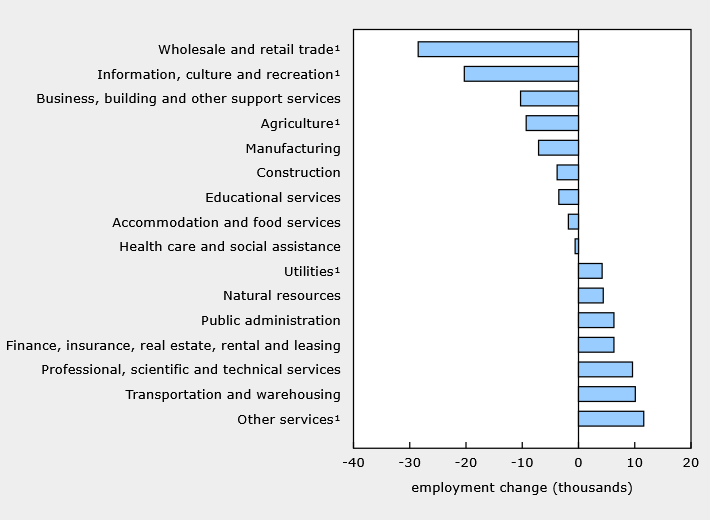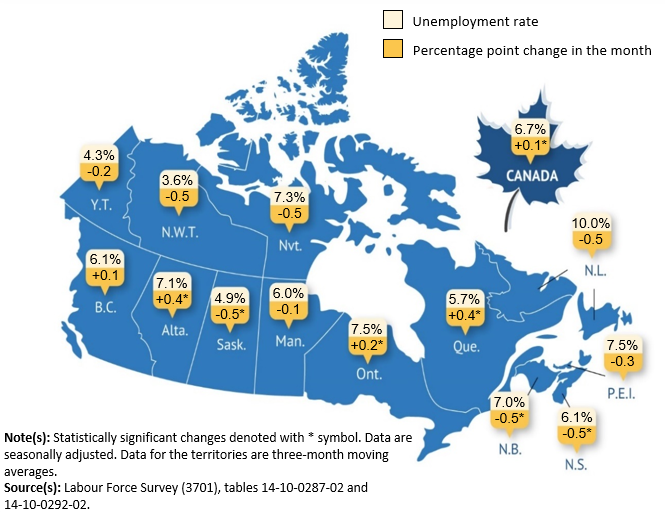March sees pullback in full-time work, with drop of 62,000 positions

Canada’s labour market took a downturn in March, marking the first employment contraction since January 2022, with a net loss of 33,000 jobs (-0.2%).
This shift comes after a relatively stagnant February and a three-month upswing that added 211,000 positions (+1.0%) late last year, says Statistics Canada in its Labour Force Survey.
The dip was largely due to a pullback in full-time work, which saw a notable drop of 62,000 positions (-0.4%).
"A downbeat report,” says Indeed senior economist Brendon Bernard.
“The spurt of momentum in the job numbers at the turn of the year ended up being short lived. Conditions weakened in March, after a flat February, as employment slipped, while total hours worked only barely edged up, following a sharp weather-induced drop. The employment drop was concentrated among full-time private sector employees, only partially offset by a rise in self employment, which has perked up in recent months.”
Employment rate drops to 60.9%
The overall employment rate also fell slightly, down 0.2 percentage points to 60.9%, partially reversing the 0.3-point gain observed between October 2024 and January 2025.
Private sector employment led the decline, shedding 48,000 jobs (-0.3%). That said, the sector remains ahead of last year’s figures, up 175,000 (+1.3%) year-over-year. Meanwhile, public sector hiring was virtually flat for the third consecutive month, although it was up 92,000 (+2.1%) over the year. Self-employment remained unchanged in March but has grown 3.0% year-on-year, says StatCan.
Older male workers hit hardest
Job losses were concentrated among older men, with 21,000 fewer employed in March (-0.9%). Since the start of 2025, this demographic has seen a cumulative drop of 47,000 jobs (-1.9%). Their employment rate now sits at 38.8%, after a third straight month of decline.
For core-aged men (25 to 54), employment edged down slightly by 16,000 jobs (-0.2%), with a corresponding drop in the employment rate to 86.3%, says StatCan.
“Gauging the contribution of swirling tariff winds is the key question in the soft March numbers, but we didn’t see the smoking gun,” says Bernard. “Instead, March’s weakness stemmed from a continuation of the trends that weighed on the job market in 2024, namely, slow hiring, which has made it tougher for those out of work to land a job.”
By contrast, employment levels for core-aged women and older women held steady. Among youth, the labour market remained relatively stable, though their employment rates have slipped over the year.
Job cuts in retail and recreation
Wholesale and retail trade bore the brunt of sector-specific declines, losing 29,000 jobs (-1.0%) in March—partially undoing gains from February.
Employment in the information, culture, and recreation sector also shrank by 20,000 jobs (-2.4%), while agriculture shed 9,300 positions (-3.9%).

Some bright spots remained: the "other services" sector added 12,000 roles (+1.5%), and utilities gained 4,200 jobs (+2.8%), says StatCan.
Regional divergence
Ontario recorded the largest provincial drop with 28,000 fewer jobs (-0.3%), largely in information, culture and recreation (-23,000; -6.2%) and support services (-13,000; -4.2%). Alberta lost 15,000 positions (-0.6%), driven by manufacturing and retail.
Both provinces saw their unemployment rates climb—Ontario to 7.5%, Alberta to 7.1%.

Saskatchewan bucked the trend, adding 6,600 jobs (+1.1%) and achieving the lowest unemployment rate nationwide at 4.9%. Quebec's job numbers held steady, but more job seekers pushed the province’s unemployment rate up to 5.7%, says StatCan.
The territories continued to report stronger employment figures than the national average. The Northwest Territories saw their employment rate climb 2.1 percentage points to 68.1%, while Yukon held steady at 71.8%. Nunavut’s employment rate remained low at 53.6%, with just 45.0% of the Inuit population employed.
Unemployment creeps up to 6.7%
Canada’s unemployment rate ticked up to 6.7% in March—its first increase since November 2024. While still below the November peak of 6.9%, the jobless rate has remained above the pre-pandemic average of 6.0% recorded from 2017 to 2019, says StatCan.
The rise in unemployment was driven in part by more young women entering the job hunt, pushing their unemployment rate up by 1.4 percentage points to 13.1%.
Long-term unemployment on the rise
Approximately 1.5 million Canadians were unemployed in March, a monthly increase of 36,000 (+2.5%). Compared to a year ago, that’s 167,000 more unemployed individuals (+12.4%). The share of long-term unemployed—those looking for work for 27 weeks or more—rose to 23.7%, up from 18.3% a year earlier.
Transitions from unemployment to employment also declined. Only 14.7% of those unemployed in February found jobs in March, down from 18.6% a year earlier, the report noted.
Job loss through layoffs remains the most common reason for unemployment, affecting 44.1% of those out of work. Most of these individuals last worked in construction (18.4%) or wholesale and retail trade (12.4%).



